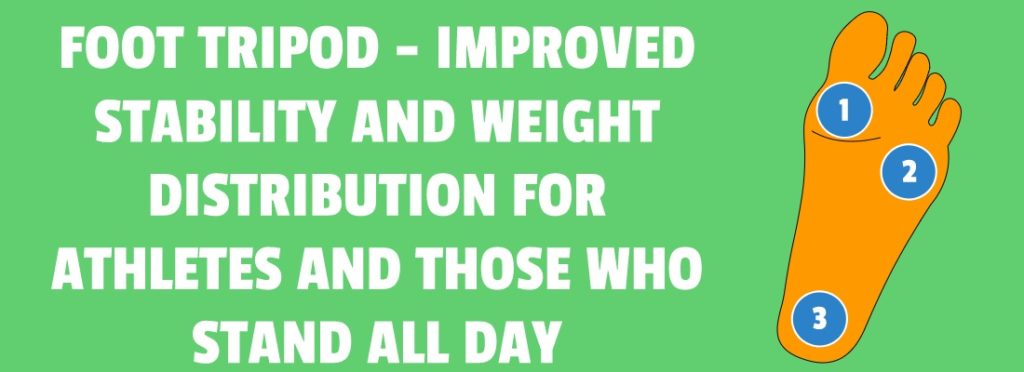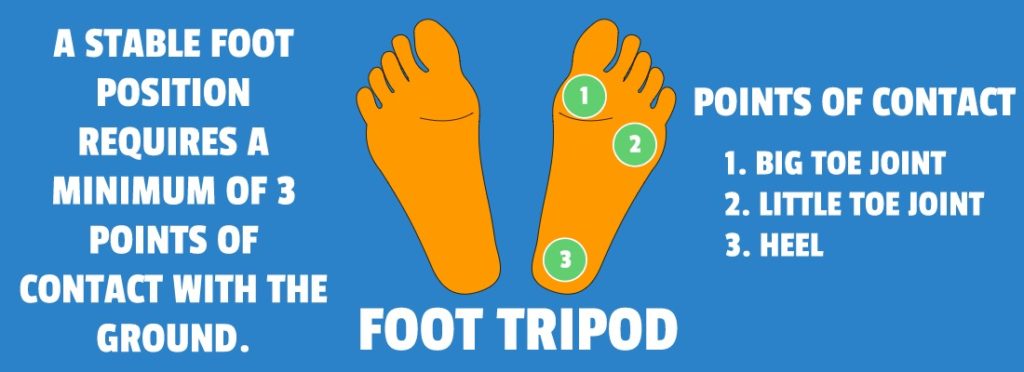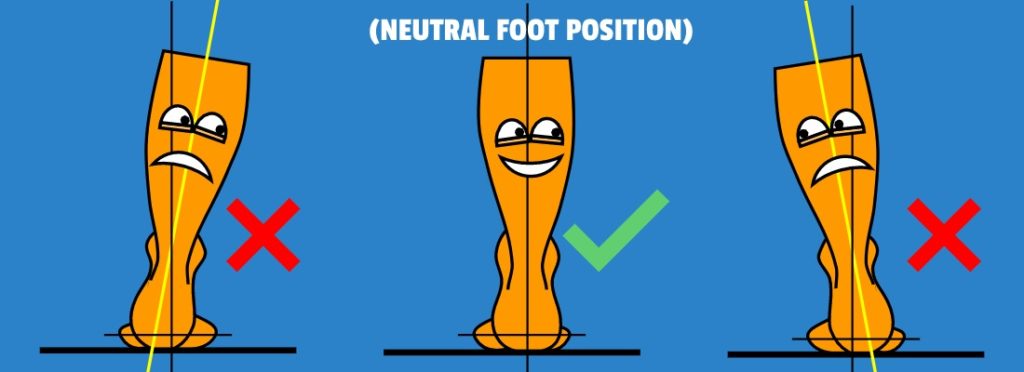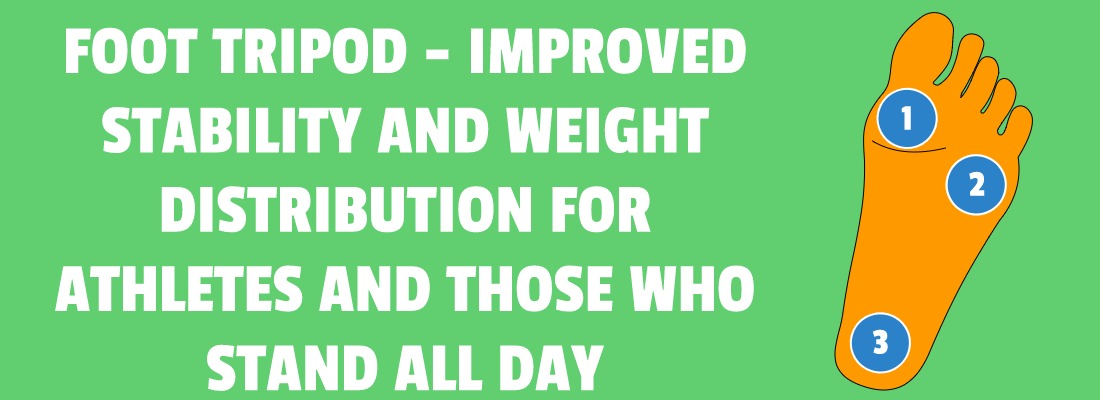Foot Tripod – What Is It And How Does It Help?
The foot tripod consists of 3 distinct points on the bottom of the foot. When these 3 points make contact with the ground the foot achieves optimum weight distribution and maximum stability.

Points Of Contact Of The Foot Tripod
The 3 points of contact at the bottom of the foot that constitute the Foot Tripod are:
- The center of the heel (also known as the calcaneus)
- The bone that attaches to the base of the 5th toe (also known as the 5th metatarsal head)
- The bone that attaches to the base of the 1st toe (also known as the 1st metatarsal head)

Identification – How To Identify The Foot Tripod
In order to identify the foot tripod, it is necessary to place the foot in a neutral position. To do this, you will need to figure out whether you over pronate or supinate when standing.
Simply put, if you have weak arches, or have flat feet or forefoot varus, it is likely that you over pronate. If you have high arches, it is likely that you supinate slightly.
What we are looking for is a straight line formed by the Achilles tendon with the heel and the calf (as shown in the figure below).
The heel should not create an angle with the ground in any direction.

Procedure: Placing both feet on the ground, squeeze your glutes. This will put your pelvis in a neutral position. From here, lift your toes and see if you can feel all three points of the tripod make contact with the ground.
If you can’t you most likely have some form of forefoot varus or a forefoot valgus that needs to be corrected.
Foot Tripod Exercises – Improve Your Balance And Stability
The following are the best exercises to strengthen the foot in the tripod position. For best results, make sure to follow them in the order mentioned below.
- Foot Tripod Massage And Activation Exercise: The aim of this exercise is to massage and activate the muscles responsible for holding the foot in the tripod position. In order to perform this massage, locate the center of the heel with your hands. Using the thumbs of your hands, massage back-and-forth from center of your heel to the base of the big toe. Perform this movement 5 times, taking your time to iron out any tight spots that you may find. Next, continue from the center of the heel, massaging your way back and forth to the base of the little toe. This exercise helps identify the points of the tripod and also increases blood flow, thereby increasing mobility and elasticity in the foot.
- The Flamingo: The second foot tripod exercise that I’ve always used to increase my balance and stability is the “Flamingo”. If you picture a Flamingo standing, the name of this exercise says it all. It involves standing on one foot while maintaining proper alignment of the foot, knees and hips. To perform this exercise, keep your foot in the neutral foot position as mentioned above (in the section – ‘How to identify foot tripod’). Once in a neutral foot position, squeeze your glutes while lifting one foot in the air. Place all 3 points of the tripod on the floor. Raise the arch of the foot (which is on the ground) by trying to grip or grab the ground with the foot. Hold this position for as long as possible before switching to the next leg. Repeat this exercise on each foot. Working your way up from a minute on each foot, up to 5 minutes.
Application Of The Foot Tripod
Have you ever noticed that some people are more stable on their feet than others?
Sumo wrestlers for example, strive to be the most stable on their feet.
Their sport revolves around the rikishis (wrestlers) trying to force each other off balance or out of the ring. If a rikishi is forced out of the ring, or made to touch the ground with anything other than the soles of his feet, the match is over.
Keeping center of gravity low in this sport is of utmost importance, but so weight distribution and overall stability.
Every time you see a wrestler fall, you will more than likely see him lose the placement of his foot tripod.
This is because the wrestler with a more stable foot tripod will distribute his weight more evenly across the entirety of his foot, enabling better stability.
Weight distribution and stability are also extremely important for athletes who want to generate maximum power. But, the concept of a foot tripod can also be used in day-to-day life, especially for those who stand on their feet all day.
Note: While the three ‘legs’ of the tripod must touch the ground for maximum stability, this does not mean that the rest of the foot should not. In fact, it can be argued that if all three legs of the tripod touch the ground, then it is desirable for other areas of the foot to touch the ground as well.
Also, the foot doesn’t necessarily have to be in the tripod position at all times. The foot is able to flex and adapt naturally to its environment and surroundings.
What Causes A Loss In Foot Tripod Position?
There are several reasons for the loss in the foot tripod position.
- The most common being the loss of strength in the arches of the foot (flat feet).
- Having a forefoot varus (either rigid or flexible)
- Weakness in the muscles of the calf
Individuals with flat feet or forefoot varus tend to shift their weight towards the base of the big toe. This causes the heel to tilt at undesirable angle while standing.
How The Foot Tripod Affects The Squat
One of the major problems associated with the loaded barbell back squat is the buckling/caving in of the knees. This usually happens because the load is too much for the athlete to properly squat back up with good form. But a small rectification in the positioning of the feet can increase your squat by a a couple of points.
When the foot tripod is not properly executed, the foot starts to overpronate. This leads the ankles, and knees inward, which in turn causes the rounding of the back.
Trainers will often tell their athletes to push their knees outward. This is an excellent queue to keep in mind, but what ends up happening is, in order to keep the knees out, the athlete will lose integrity in the foot tripod in the opposite direction. Thus reducing stability and improper weight distribution which causes the break down of form.
A better queue would be to try to grab the ground with the feet, thus creating a solid tripod foot. This will keep the knees trailing in line with the feet, and increase weight distribution and stability.
Conclusion:
Learning the foot tripod position is important for athletes and those who stand on their feet all day. Learning this position can:
- Alleviate fatigue and pain caused due to injury.
- Maximize stability and optimize weight distribution.
- Generate additional force required in certain movements like the squat.
- Help correct improper foot mechanics.
I sincerely hope you start to incorporate the foot tripod exercises in your daily routine.

